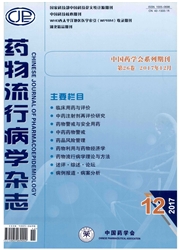

 中文摘要:
中文摘要:
目的:通过定期跟踪随访,调查华法林抗凝治疗的现状。方法:选择华法林抗凝治疗住院患者,且出院后继续抗凝治疗至少3个月,收集患者住院期间的临床资料,并在出院后定期跟踪随访。结果:在375例接受随访的患者中,234例达到稳定抗凝治疗。心脏瓣膜置换患者的华法林抗凝治疗依从性最好,其次为静脉血栓和肺栓塞患者,房颤患者的依从性最差。使用华法林首次负荷剂量者更易达到稳定抗凝效果;在发生出血并发症的患者中,女性显著多于男性,且5d内INR达到或超过目标范围的患者比例高。结论:治疗起始阶段的剂量和INR值以及性别是影响华法林达到稳定治疗和出血并发症的主要临床因素。应加强对房颤患者出院后华法林抗凝治疗的指导。
 英文摘要:
英文摘要:
Objective:To evaluate the status of warfarin anticoagulation in Chinese by regular follow-up study. Method:Hospitalized patients prescribed with warfarin for at least three months were recruited serially. Their clinical data in hospital were collected. Regular follow-up by telephone was initiated when they were discharged and lasted for three months. Result:A total of 375 patients were recruited, with 234 cases attained their stable anticoagulation during the fol- low-up. Patients underwent cardiac valve replacement had the best compliance, followed with the patients of vein thrombosis and pulmonary embolism. Patients of atrial fibrillation had the least compliance of warfarin treatment. Patients initiated with loading dose of warfarin or with INR values in initial 5 days higher than the target value achieved their stable anticoagulation more easily. Conclusion:It's necessary to strengthen the warfarin anticoagulation in Chinese atrial fibrillation patients. Loading dose of warfarin, INR values in initial stage, as well as gender could affect the time to table anticoagulation and haemorrage compliances of warfarin.
 同期刊论文项目
同期刊论文项目
 同项目期刊论文
同项目期刊论文
 High Levels of Inflammation and Insulin Resistance in Obstructive Sleep Apnea Patients with Hyperten
High Levels of Inflammation and Insulin Resistance in Obstructive Sleep Apnea Patients with Hyperten 期刊信息
期刊信息
